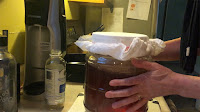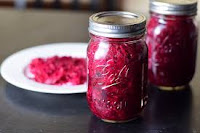Not Nashville, But How About We Talk About Kombucha
See on YouTube:
It's Kombucha time!
Ahhhhhh, Kombucha. What is it and what is that THING that floats at the top? A mushroom? A living being? What is it? Why, it's a SCOBY of course. A SCOBY is a "Symbiotic Colony of Bacteria and Yeast". It's all those bacteria and yeasts that are good for our gut all slopped into one big slimy GELATINOUS film. A SCOBY forms when oxygen and the liquid containing the bacteria and yeast intermingle. SCIENCE... I guess.
A SCOBY is the essential ingredient in Kombucha. It helps transform an otherwise simple sweet black tea into the very complex flavors in the slightly fizzy beverage found in the hands and homes of most of today's Millennials. Oh, and some of us elders who took a chance on something that looked absolutely GROSS and tasted slightly like vinegar.
You can find a tremendous variety of Kombucha on the shelves of virtually every major grocery store or food co-op. The flavors can vary from fruity, to spicy, to sweet, to sour and everything in between. It can be tasty, and it can be awful! By awful, I mean a mouth full of vinegar. I find the tastiest Kombucha has either a floral and sweet tea like flavor, or a fruity spicy flavor.
But the truth is, nothing beats your own homemade Kombucha! It's SOOOOO easy to make. You don't even have to have a SCOBY to do it. You need a couple ingredients, a food grade glass jar, rubber bands or kitchen twine, a cloth to cover it all and a dark room.
So let's get 'er done! Let's make this as if it were our very first batch.

Ingredients:
A SCOBY (if you have one)
8 organic (if possible) black teabags
1 cup of organic sugar
A gallon of cold filtered water
A 16 oz bottle of organic and raw unflavored Kombucha (I use GT's Original)
Equipment:
A large pot with a lid that can hold over a gallon of water
A long spoon to stir
A gallon size food grade glass jar
A tightly woven cloth and/or paper towel
2 large rubber bands or kitchen twine
Directions:
Fill your pot with 4 cups of water and bring it to a boil
If your teabags have string, tie the strings together in one knot
When the water comes to a boil, turn it off and drop in your teabags.
 With the lid on the pot, Steep the tea for 30 minutes off of the heat.
With the lid on the pot, Steep the tea for 30 minutes off of the heat.
After 30 minutes, remove the teabags and add in your sugar.
Stir until all of the sugar is dissolved.
Stir in the gallon of cold filtered water.
Check the temperature of the Kombucha. If it is above 85*, let it cool to room temperature or between 70-85*
If you do not have a SCOBY, please skip down to "Kombucha with NO SCOBY"
Kombucha with SCOBY:
Pour the sweetened tea in the glass jar. Make sure to leave at least 2 inches at the top.
Shake up and pour in your organic and raw unflavored Kombucha.
If you have a SCOBY, now is the time to put it in the jar. It may sink to the bottom, but will eventually float.
Cover the jar with a tightly woven cloth like a linen towel. If it isn't as tightly woven as you like, place a sheet of paper towel under the cloth. Secure the paper towel with a rubber band and put the cloth towel over it. Secure the cloth towel tightly with another rubber band.
As it eats the sugars in the tea it will grow and begin to ferment it into a beautiful batch of Kombucha.
Kombucha with no SCOBY:
If you do not have a SCOBY, you will be growing your SCOBY first.
You may wish to start with a quart or a little less of tea.
Pour the sweetened tea in the glass jar.
Shake up and pour in your organic and raw unflavored Kombucha.
Cover the jar with a tightly woven cloth like a linen towel. If it isn't as tightly woven as you like, place a sheet of paper towel under the cloth. Secure the paper towel with a rubber band and put the cloth towel over it. Secure the cloth towel tightly with another rubber band.
In about a week you will begin to see a light film floating at the top. This is your SCOBY.
When it thickens to about a quarter inch, you may use this to create your first batch of Kombucha.
Follow the instructions above.
I hope you have an opportunity to make your own Kombucha. Or in my case - rescue my Kombucha (see the video). Thank you for reading.
It's Kombucha time!
Ahhhhhh, Kombucha. What is it and what is that THING that floats at the top? A mushroom? A living being? What is it? Why, it's a SCOBY of course. A SCOBY is a "Symbiotic Colony of Bacteria and Yeast". It's all those bacteria and yeasts that are good for our gut all slopped into one big slimy GELATINOUS film. A SCOBY forms when oxygen and the liquid containing the bacteria and yeast intermingle. SCIENCE... I guess.
A SCOBY is the essential ingredient in Kombucha. It helps transform an otherwise simple sweet black tea into the very complex flavors in the slightly fizzy beverage found in the hands and homes of most of today's Millennials. Oh, and some of us elders who took a chance on something that looked absolutely GROSS and tasted slightly like vinegar.
You can find a tremendous variety of Kombucha on the shelves of virtually every major grocery store or food co-op. The flavors can vary from fruity, to spicy, to sweet, to sour and everything in between. It can be tasty, and it can be awful! By awful, I mean a mouth full of vinegar. I find the tastiest Kombucha has either a floral and sweet tea like flavor, or a fruity spicy flavor.
But the truth is, nothing beats your own homemade Kombucha! It's SOOOOO easy to make. You don't even have to have a SCOBY to do it. You need a couple ingredients, a food grade glass jar, rubber bands or kitchen twine, a cloth to cover it all and a dark room.
So let's get 'er done! Let's make this as if it were our very first batch.

Ingredients:
A SCOBY (if you have one)
8 organic (if possible) black teabags
1 cup of organic sugar
A gallon of cold filtered water
A 16 oz bottle of organic and raw unflavored Kombucha (I use GT's Original)
Equipment:
A large pot with a lid that can hold over a gallon of water
A long spoon to stir
A gallon size food grade glass jar
A tightly woven cloth and/or paper towel
2 large rubber bands or kitchen twine
Directions:
Fill your pot with 4 cups of water and bring it to a boil
If your teabags have string, tie the strings together in one knot
When the water comes to a boil, turn it off and drop in your teabags.
 With the lid on the pot, Steep the tea for 30 minutes off of the heat.
With the lid on the pot, Steep the tea for 30 minutes off of the heat.After 30 minutes, remove the teabags and add in your sugar.
Stir until all of the sugar is dissolved.
Stir in the gallon of cold filtered water.
Check the temperature of the Kombucha. If it is above 85*, let it cool to room temperature or between 70-85*
If you do not have a SCOBY, please skip down to "Kombucha with NO SCOBY"
Kombucha with SCOBY:
Pour the sweetened tea in the glass jar. Make sure to leave at least 2 inches at the top.

Shake up and pour in your organic and raw unflavored Kombucha.
If you have a SCOBY, now is the time to put it in the jar. It may sink to the bottom, but will eventually float.
Cover the jar with a tightly woven cloth like a linen towel. If it isn't as tightly woven as you like, place a sheet of paper towel under the cloth. Secure the paper towel with a rubber band and put the cloth towel over it. Secure the cloth towel tightly with another rubber band.
As it eats the sugars in the tea it will grow and begin to ferment it into a beautiful batch of Kombucha.
Kombucha with no SCOBY:
If you do not have a SCOBY, you will be growing your SCOBY first.
You may wish to start with a quart or a little less of tea.
Pour the sweetened tea in the glass jar.
Shake up and pour in your organic and raw unflavored Kombucha.
Cover the jar with a tightly woven cloth like a linen towel. If it isn't as tightly woven as you like, place a sheet of paper towel under the cloth. Secure the paper towel with a rubber band and put the cloth towel over it. Secure the cloth towel tightly with another rubber band.
In about a week you will begin to see a light film floating at the top. This is your SCOBY.
When it thickens to about a quarter inch, you may use this to create your first batch of Kombucha.
Follow the instructions above.
I hope you have an opportunity to make your own Kombucha. Or in my case - rescue my Kombucha (see the video). Thank you for reading.
I'd like to grow my readership. If you enjoyed this blog post, add a comment and share it with a friend. 😀 Please visit, subscribe and like my YouTube channel Kickin' it with Karen: Beyond Sauerkraut to find more things I've made.







Comments
Post a Comment